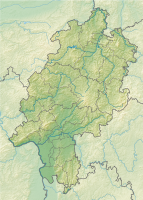Stolzenbach mine
| Stolzenbach mine | |||
|---|---|---|---|
| General information about the mine | |||
| Pit connection line in the loading station in 1987, no longer available today | |||
| Mining technology | Underground mining | ||
| Information about the mining company | |||
| Operating company | Prussian Electricity AG | ||
| Start of operation | 1956 | ||
| End of operation | 1988 | ||
| Funded raw materials | |||
| Degradation of | Brown coal | ||
| Mightiness | 6 m | ||
| Greatest depth | 170 m | ||
| Geographical location | |||
| Coordinates | 51 ° 0 '39 " N , 9 ° 17' 35" E | ||
|
|||
| Location | Stolzenbach | ||
| local community | Borken (Hesse) | ||
| District ( NUTS3 ) | Schwalm-Eder district | ||
| country | State of Hesse | ||
| Country | Germany | ||
| District | Borken brown coal area | ||
The pit Stolzenbach (also pit pride Bach ) was a downhole brown coal - mine in Borken coal mining area . The pit promoted from 1956 to 1988 from about 60 to 170 m depth , and was one of the few mines in Germany, in which after the Second World War still lignite underground mined was. Most of the coal mined went to the Borken power station . The company was shut down after the Stolzenbach mine disaster .
advancement
The lignite was extracted in three fields : north field, east field and south field.
- North field
The northern field extends from Stolzenbach in a north-westerly direction to Borken under the Weinkopf and in an easterly direction to Marienrode . The northern field was completely dismantled.
- Ostfeld
The Ostfeld extends from Stolzenbach in a north-easterly direction to Pfaffenhausen and just before Freudenthal .
- Südfeld
The southern field extends from Stolzenbach in a south-easterly direction to Frielendorf and in a south-westerly direction to Dillich . The southern field was completely dismantled.
The seam thickness averaged six meters in all fields.
The lignite was mined using expansion and strip breaking methods . The route system of the partially parallel material and conveyor routes in the mine, which were connected with cross cuts, comprised approximately 27 kilometers. The track system followed an adapted the Flözverlauf sole . An overhead monorail ran in the 320 meter long sloping material tunnel with an incline of 10 ° . It was powered by diesel - hydraulic pulling trolleys . The overhead monorail was used for the transshipment-free transport of pit lining material , technical equipment and tools. About armored conveyors and belt conveyors the mined lignite in was above ground , 600 tonne capacity bunker promoted. The inclined belt tunnel used here had a gradient of 16 °. The lignite was delivered from the bunker to the Borken power station by a works railway .
In the 1950s , drilled Seilfahrt Schacht was last mainly for the transport of buddy used.
Mine disaster
In a disaster on June 1, 1988, caused by a coal dust explosion , 51 miners were killed. Six miners survived in an air bubble at a depth of 150 meters. The survivors were located 65 hours after the accident by a Hessischer Rundfunk microphone through a drilled ventilation pipe and rescued on June 4th. The "Stolzenbachhilfe" was founded to provide acute care for victims and auxiliary workers (see also: Emergency Pastoral Care , Crisis Intervention ). The Stolzenbach mine was not reactivated after the accident.
Paleontological finds
The pit was an important paleontological site for Eocene pond turtles (Palaeoemys hessiaca and Borkenia oschkinisi) .
literature
- Viktor Oschkinis and Hans-Joachim Gregor: Paleontological finds from the Eocene brown coal of the Stolzenbach underground mine (PreußenElektra) in Lower Hesse . 1992.





